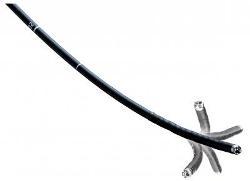Nov 11 2009
New scope's smaller diameter offers advanced insertion capability and enhanced patient comfort
 Olympus introduces the world's smallest gastrointestinal videoscope to offer four-way angulation and Narrow Band ImagingT (NBI) to detect upper gastrointestinal abnormalities
Olympus introduces the world's smallest gastrointestinal videoscope to offer four-way angulation and Narrow Band ImagingT (NBI) to detect upper gastrointestinal abnormalities
Olympus today introduced the world's smallest gastrointestinal videoscope to offer four-way angulation and Narrow Band Imaging™ (NBI) to detect upper gastrointestinal abnormalities. The super-slim scope is 5.5 mm in diameter at the distal end, as well as the insertion tube, and offers exceptional insertion capability to enhance patient comfort. The scope also features NBI, Olympus' proprietary imaging technology that filters white light to consist of specific wavelength bands enabling enhanced observation of microvessels and subtle changes on the mucosa. Together, these features provide greater flexibility to obtain remarkably clear views and visual contrast which can help to distinguish anatomical structures and fine capillary patterns that are critical components of a physician's diagnosis.
Unlike conventional super-slim scopes that only bend in two directions, the GIF-XP180N scope bends in four directions, enabling thorough examination of the upper gastrointestinal tract and optimal scope maneuverability for doctors. This feature makes the scope ideal for use in special clinical cases such as transnasal insertion and in patients with severe strictures and small anatomy. It is anticipated that the scope's super-slim design will allow routine examinations to be performed with little or no sedation, while minimizing patient discomfort.
"We have used the XP180N for various procedures including unsedated endoscopy and endoscopy in patients with tight strictures," said gastroenterologist Dr. Amitabh Chak, professor of medicine at Case Western Reserve University School of Medicine. "Compared to two-way angulating scopes, the major advantages of the XP180N are its maneuverability, its ability to biopsy more easily and the ease of intubating the duodenum," added Chak.